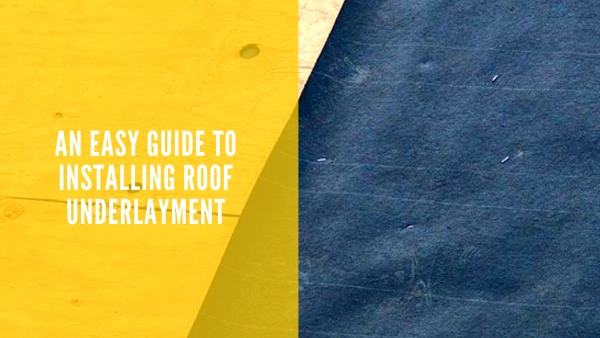
An Easy Guide to Installing Roof Underlayment
As the seasons change, you may notice that your roof has started to deteriorate. Because of that, you may be wondering what kind of underlayment is best for your home. Now, it’s time to turn your attention to installing roof underlayment.
Though it may seem like an easy thing to do, there are some things you need to keep in mind when deciding how much will need to install your roof underlayment. This article will discuss what roofing underlayment is, the different types of roofing underlayment, its exposure life, and the things you need to consider before installing a roof underlayment.
What is roof underlayment?
Roof underlayment is a material installed directly to your roof deck to protect your home from moist caused by severe weather conditions. It is what goes on top of the sheathing materials of your roof. It also provides a barrier for roof leaks to be absorbed.
Why is roof underlayment important?
Shingles are a great first line of defense for your home, but they need more layers to offer the comprehensive protection that your home needs. They reflect the sun’s rays and block wind while defending against precipitation. However, they don't have sealed corners and they overlap, which means strong enough winds can lift them. This makes them prone to tearing off and deterioration. That is why installing roof underlayment is important in keeping them intact.
Types of roof underlayment
Felt underlayment
Felt roof underlayment is commonly referred to as felt paper, this type of roof underlayment is one of the first in the market. To help with water resistance, this organic mat paper is soaked with asphalt. It usually comes in two sizes: No. 15 felt and No. 30 felt.
Although it is less popular to use in the market nowadays, some contractors still prefer to use this type of roof underlayment because of its less expensive price. But the downside is that because it is heavier than other types of roof underlayment, it is quite challenging to install.
How long can felt roof underlayment be exposed? Because this roof underlayment is paper-based, it is only water-resistant and not fully waterproof. If it gets wet, it might wrinkle. As such, felt roof underlayment can be exposed longer on the roof during the dry season.
Synthetic underlayment
Synthetic roof underlayment is a waterproof and tear-resistant roofing product that is meant to be installed across the entire roof deck. Its base mat is soaked in asphalt and fiberglass to give excellent tear resistance and stability.
Unlike felt roof underlayment, synthetic roof underlayment is more expensive. But the good thing is, it’s much lighter so it can be installed faster. It is also more rain and cold-resistant, does not absorb moisture, and can withstand heavy winds. This is why most contractors prefer this roof underlayment over felt underlayment. In fact, according to research, the enhanced protection that synthetic roof underlayment gives is boosting the growth of the overall roof underlayment market.
How long can synthetic roof underlayment be exposed? This type of roof underlayment can last from 6 months up to a year, much longer than felt paper.
Rubberized Asphalt
This water-resistant roof underlayment is perfect for roofing with a sticky back that helps it adhere to the roof deck. This is due to the high percentages of asphalt and rubber polymers contained in the underlayment.
Because of its top-quality material and waterproofing, this type of roof underlayment is the most expensive. But if you have the money and you live in areas with wet climates, then this is the perfect roof underlayment for you.
How long can synthetic roof underlayment be exposed? Rubberized asphalt roof underlayment gives a complete seal, making it last longer especially during winter.
How much will you need to install?
There are two ways to calculate how much roof underlayment you need for your roof. One method estimates that an average of 15 to 20 square feet is required, while the other gives an average of 10 to 20 square feet of roof underlayment required per inch of shingles.
To start, measure your home to get a general idea of how much space you have. Then divide that number by the square footage of shingles on the roof. If your home has an attic, you may also need to determine how much of the attic you can use as attic space. Finally, you should take into account the size of the roof (i.e., the area between the ridgeline and the ridge cap) as well as the type of roofing material that is being installed.
Before you start installing roof underlayment
Make sure you read our guide to purchasing roofing felt before purchasing roof underlayment. The initial purchase will require you to get an exact count of your roof’s surface area. That way, you can tell how much roofing felt you need to purchase.
When purchasing roofing felt, it’s important that you make sure it is not brittle. Avoid using any products with the words “spin-resistant” or “break-resistant” in their description. This type of felt is actually neither breakable nor resilient. It’s just there to be as lightweight as possible and is most often used on tiles. If your roof has asphalt or concrete surface, you should avoid using this type of felt at all.
You might also need to thoroughly research before considering whether to install a felt roof underlayment or a synthetic roof underlayment. Estimating your budget would also help in choosing which type to go with.
Conclusion
A properly installed roof underlayment can make a huge difference in your home’s overall look and improve your energy efficiency. Not only are they sturdy enough to stand up to anything, but they also do an excellent job of keeping you safe and secure throughout the year.
However, before going straight to installing these underlayments, it is crucial that you know how much you will need, the type of underlayment right for you, and your budget. Considering these before finding a contractor will save you time and money.
Roofing Service with Sunlight Homes
If you’ve decided to up your home’s roofing game and are looking for a contractor, turn to Sunlight Homes for excellent service. Sunlight Homes is located at 21610 Lassen St. Suite 1 Chatsworth, CA 91311. We are committed to socially and environmentally progressive home improvements and we believe in using the best products available in the marketplace. Our services include roofing, domestic insulation, texcote painting, heating, and air conditioning, and many more. You can check out the full list of our services here or inquire at (818) 626-8197. You may also schedule an appointment through our website. For any problems or questions, you may reach us at our contact page. Make your home moist and leaf-free!


